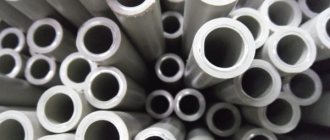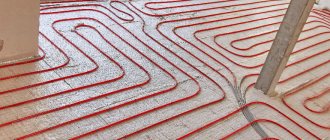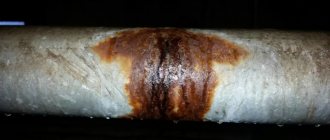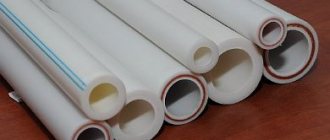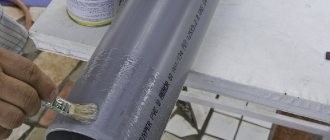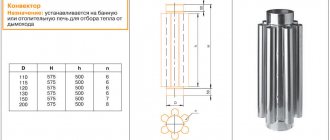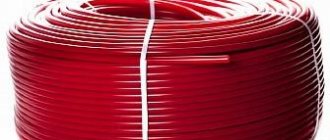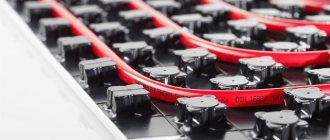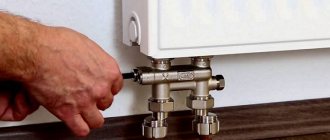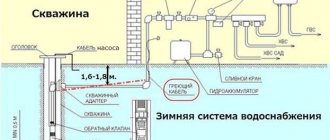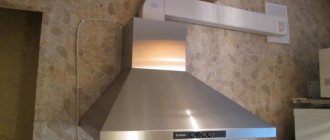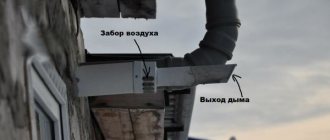When it comes to installing or reconstructing a utility system, the question arises as to which pipes are best to use. Today there is a wide range of such products on the market. They are made from materials such as copper, steel, aluminum, metal-plastic and polymers.
The most expensive material is copper pipe. Therefore, in order to save money, it is used extremely rarely. But there are exceptions. Far-sighted people opt for a copper pipe. And this is not surprising. After all, with its help you can build a strong and durable pipeline that has high performance characteristics.
Variety of copper products
Copper pipes are classified according to different criteria. One of the main ones is the method of their manufacture. According to this criterion, products are divided into the following types:
- Unannealed copper pipes. Manufactured from pure metal by rolling or stamping. The pipes have high strength and can easily withstand pressure of 450 MPa. There are some drawbacks to using this method. The result is a material with reduced ductility, which somewhat limits its scope of application.
- Annealed. Pipe processing is carried out using a special technology. Its essence is to heat the material to 700 degrees and then cool it. Cooling is carried out gradually. As a result of this treatment, copper products lose strength. In return, its plasticity increases. Due to this feature, copper pipe is widely used for the construction of pipelines that have a complex configuration.
According to the standards, copper pipes are manufactured in three types, which have characteristic differences in terms of mechanical and operational properties. So, depending on the degree of hardness, copper products are divided into the following types:
- Solid. The products are widely used for pipeline construction, which must have high strength. The distribution of pipes during the installation process is carried out only by preheating. The pipeline may have numerous turns. To bend the pipe at the selected angle, you need to use a pipe bender.
- Semi-solid. Copper pipes of this type can easily withstand distribution if the diameter is increased by 15%. The product has greater ductility than the previous material. But, nevertheless, for bending you need a pipe bender.
- Soft pipes. Able to withstand distribution when the diameter increases by a quarter. In this case, ruptures and cracks do not occur. The product is easy to bend. To do this, you do not need to heat the material. Soft copper pipes are widely used for heating and water supply systems. They have also found wide application in laying heated floors.
Copper pipes are also classified according to their cross-sectional shape. They come in round or rectangular shapes. The latter option is much more expensive. Rectangular pipes are used for the manufacture of special conductors in electrical equipment. Also, copper pipes can have different wall thicknesses (0.6 - 3 mm) and diameters (12 - 267 mm). Products with certain parameters are used in different areas. Thus, for the installation of a gas pipeline, pipes are used whose wall thickness is 1 mm, and in plumbing - 2 mm.
Methods for welding copper pipes
The necessary equipment and electrodes are selected depending on the required tightness of the seams, purpose and technical characteristics. Copper pipes can be welded using electric and gas welding. Electrodes that are melting and non-melting are used.
We recommend: Heating a garage: the most economical way of all options
Fusible electrodes
When connecting manually, coated electrodes are used, which melt. The result is a joint without defects, but the place where the copper pipe is welded will differ from the base material. This phenomenon occurs due to the presence of additional substances, alloying metals.
Additives are contained in fusible electrodes; for this purpose, silicon, manganese, phosphorus, tin and zinc additives are used. Spars, silicon copper, material based on iron and manganese, as well as ferrosilicon are introduced into the coating. Liquid glass is used for the base of the covering layer.
The disadvantages of the method include:
- decreased thermal and electrical conductivity;
- formation of a large amount of splashes;
- the appearance of pores at the junction;
- difference in the composition of the seam from copper.
To reduce defects, flux additives are used, as well as rods consisting of bronze.
Non-fusible electrodes
The pipes are connected in a protected environment, where electrodes are used that are not subject to melting during the cooking process, consisting of metal tungsten up to 10 mm in thickness. To provide a protective cloud, argon, helium or nitrogen is supplied to the weld.
The technological process takes place at a direct current with straight polarity. The electrode is a tungsten rod with the addition of lanthanum and yttrium. The movement occurs at a certain angle, and additional heating of the welding site is used.
Electrodes made of carbon and graphite are used for simple connections; they are sharpened to a cone; direct current with reverse polarity is used. Phosphorus additives and special borax fluxes are added.
Copper products with insulating coating
Among other things, copper pipes may have an additional insulating layer. Depending on this, they are divided into several types:
- Products with foam insulation based on rubber, polyurethane foam and polyethylene foam. Such pipes are used to reduce heat loss in heating and hot water supply systems. The thickness of the insulating layer will reach 3 cm.
- Copper pipes with a polyethylene coating, the thickness of which reaches 2.5 mm. Products often have a diameter of 12 – 54 mm. Often used in heating and cold water supply systems.
- Products with polyethylene insulation up to 3 mm thick. Pipes are laid using a hidden method in a monolithic structure. The product has design features that allow you to maintain the integrity of the pipeline during temperature fluctuations.
Copper pipes are not subject to corrosion processes. Therefore there is no need to apply a protective layer. But, as for additional insulation, it will not be superfluous, especially when it comes to the construction of a heating and water supply system. Especially often, such pipes are used for laying external networks that are subject to severe loads under the influence of the external environment.
Features of heating from copper pipes
To create heating systems, copper pipes of exclusively round cross-section are used. Although manufacturers still produce rolled products with rectangular and square profiles. Products are also available in thick-walled and thin-walled versions.
The first version of pipe products is produced with a wall thickness from 0.8 mm to 10 mm using welding and a seamless method. For the second, this parameter is 0.15-0.7 mm. When installing heating with copper pipes, rolled steel is mainly used, the diameter of which is at least 3/8 inch. Regardless of the size of the product, copper heating systems have pros and cons.
Advantages and disadvantages of copper pipes in heating systems
Pipelines made of this metal have a long history: they are already more than 5 thousand years old. years. Technologies have changed, but their positive qualities remain the same:
Copper pipes can be used for a long time under certain conditions
- Long service life: with a properly designed and assembled heating system, pipes can last for decades.
- Light weight. Copper is ductile and durable, which allows you to make pipes with a small wall thickness. As a result, it turns out that it weighs a little.
- Withstands both high and low temperatures (operating temperature range from +115°C to -40°C).
- Copper of a certain grade tolerates the aquatic environment well, but for this purpose a small part of phosphorus is introduced into its composition. Such products are marked EN 1057 - in accordance with the DIN standard. Such pipes do not react with water and are used for both plumbing and heating.
- Does not require external finishing. The copper pipes themselves look attractive and do not deteriorate over time. If there is a need to paint, it is most likely due to inconsistency with the new design of the room.
Copper pipes have a fairly attractive appearance
- Not afraid of freezing: after thawing it continues to function. This is a very important quality for regions with harsh winters.
- Does not allow any gases to pass through, including oxygen, which is an active oxidizing agent.
- High resistance to oxidation.
- Smooth internal surface, which reduces the likelihood of deposits forming, unlike steel pipes (PPR and MP pipes do not have deposits).
- Low coefficient of thermal expansion.
- Like any substance, copper enters the medium it transports (with the exception of glass and ceramics). In small dosages it is useful - it has disinfectant properties. Previously, there were reports of the negative effects of large amounts of copper on health, but to date no evidence has been found and copper is not considered harmful even in large doses.
Quite a decent list of advantages. But there are also disadvantages and quite serious ones:
- Incompatibility with other materials. If there are aluminum elements in the system, active electrochemical reactions begin. When directly connected to products made from other metals, destruction occurs quickly. To improve the situation, you can use brass adapters and fittings. If you need rolled brass, it is better to use a product produced by https://nmkural.ru/catalog/latunnyy-prokat/. But it is better not to combine aluminum and copper in one system: they react, which releases a large amount of gases , so that in the absence of gas release valves the system may rupture.
In direct contact with other materials, active destruction occurs
- High price. This applies to both pipes and fittings. You also need solder, which costs a lot, and if not purchasing, then renting special equipment. The system as a whole is expensive. Especially if you consider that aluminum radiators cannot be installed, cast iron ones are a little better, but still bad, so it is advisable to install copper radiators, or bimetal with copper.
Copper pipe fittings
- If there are solid particles in the coolant, abrasion occurs quickly, since it is a soft and plastic material. Therefore, a mechanical filter is needed to remove abrasive particles from the environment.
- Insulation from stray currents is required: copper is a very good conductor of electricity. Therefore, a well-made grounding loop and the presence of dielectric spacers in the system are required.
- Difficulty of installation work: special equipment is required. But you can use bronze compression fittings, which require only wrenches (adjustable or open-end wrenches) for installation.
Crimping fittings for copper pipes can be installed by hand, but they cannot be cast into walls.
- Protection from mechanical influences or careful handling is necessary, otherwise in a few years there will be no pipes, but a shapeless pile of metal.
We recommend: Baxi boiler error e10
There are several other properties that, depending on the point of view or operating conditions, can be classified as both pros and cons:
- The first is high thermal conductivity. If copper heating pipes are laid openly, they emit a fairly large amount of heat. Therefore, fewer radiators may be required. That's a plus. When laying in a closed wall or floor, careful thermal insulation is required so that the coolant through the pipe does not transfer all the heat to the wall (this is especially possible when laying in walls facing the street). This is a minus.
- Softness and plasticity. On the one hand, this is good - using a special device, pipes can be bent within fairly large limits, which leads to fewer connections and fittings. This is good. But the softness of the material means that they need to be fixed after a short interval, and in some cases special boxes must be made: at a high temperature of the coolant, copper can soften and lose its shape. This is bad. The not most pleasant moment is that upon impact, copper pipes are deformed, therefore the coolant circulation deteriorates. As a result, with careless attitude and multiple distortions, the efficiency of the system can be greatly reduced. Not good either.
Most of the problems that may arise during the operation of water pipes are associated with low quality products. And these are not advertising gimmicks, but the results of operation: a properly designed system, consisting of proven elements, works perfectly. If there is even a small fragment of “left” material, problems begin. Example: a cold water and hot water supply system is assembled from copper, all materials are of high quality, branded, with the exception of one piece of pipe (not enough) in the hot water supply, purchased from the first tray on the market. The result is that after a year and a half of operation, a blue film appeared on the plumbing fixtures to which hot water was supplied (where there was only cold water, there were no changes). The owners had to change the entire DHW comb due to the presence of an active corrosion process in the “left” section of the pipe.
Most problems with copper piping are due to poor quality materials.
To navigate brands and buy copper pipes that are suitable for heating, you need to know the types of components produced, their types, area of operation and markings.
Advantages of copper products
Due to their performance properties, copper pipes are widely used for transporting various liquids. Among the advantages of such products are:
- Plasticity and strength. Copper products have high strength and ductility. At low temperatures, these properties increase significantly. This makes it possible to use a copper pipeline for transporting non-freezing liquids.
- Resistant to sudden temperature changes. Copper pipes do not lose their performance properties at extreme temperatures. This also applies to high blood pressure. Such pipes can withstand a load of 400 atmospheres.
- Slight thermal expansion.
- The versatility of the material. For the construction of one or another utility line, you can use pipes with a small wall thickness. So, for example, if we take steel or plastic analogues, then to solve a similar problem we needed products whose wall thickness was several times greater.
- Resistant to chlorine and other chemicals that may be contained in the transport fluid. Upon contact with copper, an oxide is formed, which extends the life of the product.
- Copper pipes are not afraid of ultraviolet rays, chemically aggressive substances and corrosion. Thanks to these properties, the service life of the pipeline can reach 100 years or more.
- Copper inhibits the development of bacteria, which makes the pipeline safe.
- The inner walls of copper products have a smooth surface. Thanks to this, pipes with a small diameter can be used to construct the pipeline. At the same time, throughput is at a high level.
- Dismantled copper pipes can be reused to construct a new heating or water supply system pipeline.
- Copper pipes have an attractive appearance. This makes it possible to abandon the installation of decorative boxes. The products themselves can be used as a decorative element.
Due to the presence of such advantages, copper pipes are especially popular among professionals and are used in various fields.
How are copper pipes made?
There are two production methods:
- Seamless;
- Welded.
Seamless copper pipe production is more common. The essence of manufacturing is to cold-roll a blank copper sleeve to the required diameter. For this:
- A copper bar is heated and a hole is made in it on a special mill - a piercing machine. A blank sleeve is obtained. The size of the blank and sleeve depends on the desired diameter of the future product.
- The sleeve is rolled on special machines, increasing the diameter to the desired size. When making a large-diameter copper pipe, the blank or sleeve may be heated several times.
We recommend that you read: How to install a ventilation duct in the kitchen with your own hands?
The production of welded copper pipe is carried out using sheet material, which is wound onto a workpiece of the required size. The seam is welded at the junction of the walls. This production method is becoming increasingly rare.
The performance and physical properties of copper pipes depend on their further processing.
There are annealed and unannealed products.
- Annealed copper pipes are more ductile. Their transportation and sale is carried out in bays. One bay can be up to 50 m.
- Unannealed pipes are sold in straight lengths. They have greater rigidity compared to rolled pipes that have not been subjected to heat treatment.
Note! In addition to the usual round products, manufacturers offer copper pipes with a square or rectangular cross-section. However, their production is more expensive, which affects the final price of the products.
Disadvantages of copper and products made from it
Of course, like any other building material, copper pipes have some disadvantages, among which are:
- High cost of copper products.
- Quite high electrical conductivity of the material. As a result, the pipeline may suffer as a result of the influence of stray currents on it.
- When passing products through a wall, special protective covers must be used. This is done in order to protect the pipeline from the negative effects of structures.
- Copper and aluminum products cannot be used simultaneously in the same pipeline. This may cause galvanic corrosion.
- If we are talking about steel pipes, then they should be located in front of copper products. This will reduce the risk of corrosion processes.
Scope of application
Copper pipes have many advantages, which has made it possible to use them in various fields. So, the products are used:
- in heating and water supply systems;
- in high pressure systems for oil supply;
- for transporting compressed air and gas;
- as freon tubes in refrigeration systems;
- for condensate drainage;
- in fuel systems;
- in air conditioning systems;
- for connecting various equipment.
Use of copper piping
The anti-corrosion properties of copper, its ductility, thermal stability, and high thermal conductivity allow the use of products made from this metal in air, heating, water supply and insulating communications.
We recommend that you read: Features of the use and installation of metal-plastic pipes
Depending on the diameter, copper pipes are used:
- In air conditioning and convector heating systems. Here they use light, thin-walled products with a diameter of 8-10 mm.
- In refrigeration units.
- In water supply systems for “home” wiring. Use pipes 15-25 mm in diameter.
- In autonomous heating systems. Diameter from 20 to 32 mm.
- The drainage system uses pipes of the largest diameter. The drain is installed with a diameter of 40-50 mm.
Due to their durability and noble appearance, copper pipes are often used as an interior item that serves as an insulator for electrical wiring.
Note! The installation of copper pipelines has its own specifics, since the connection of pipes and fittings is carried out without the use of threads.
Features of installation of copper pipelines
Before proceeding with the installation of the copper pipeline, it is necessary to take measurements and appropriate cuts. Here it is worth making sure that the cut is even. This result can be achieved using a special pipe cutter. The pipes in the main are connected by soldering or pressing.
The most common option is capillary soldering. With its help, you can achieve high reliability and tightness of connections. This method is often used to join rectangular copper pipes. In the process of capillary soldering, sockets and fittings are used. This option is ideal for constructing a pipeline that will be used at high temperatures.
As for pressing, they are performed using various fittings. This is especially true for self-fixing and compression products. In addition, during the construction of the pipeline, compression clamps and special flanges are used. The connection by pressing is used in those places where the pipeline will be exposed to open fire.
Copper pipe fittings
Crimping and solder fittings are used to connect copper pipes. The first products are made of brass. Inside there is a crimp ring that ensures the tightness of the connection. The connecting nut can be tightened manually or using a regular wrench. This greatly simplifies the installation of the pipeline.
The connection process is carried out using the following technology:
- The fitting is disassembled into its components.
- A clamp nut and also a crimp ring are placed on the copper pipe.
- The end of the pipe is inserted into the fitting.
- The nut is tightened by hand. In this case, it is worth making sure that the ring fits into the fitting without distortion.
- The nut is tightened tightly using a wrench.
Important: Connecting pipes using fittings must be done very carefully. Do not overdo it when tightening, as the crimp ring can cut through the walls of the product.
It is also worth noting here that clamp fittings are not a reliable option for connecting copper piping. After all, it is in such cases that leaks often occur. Therefore, it is necessary to periodically inspect the line for tightness of connections.
